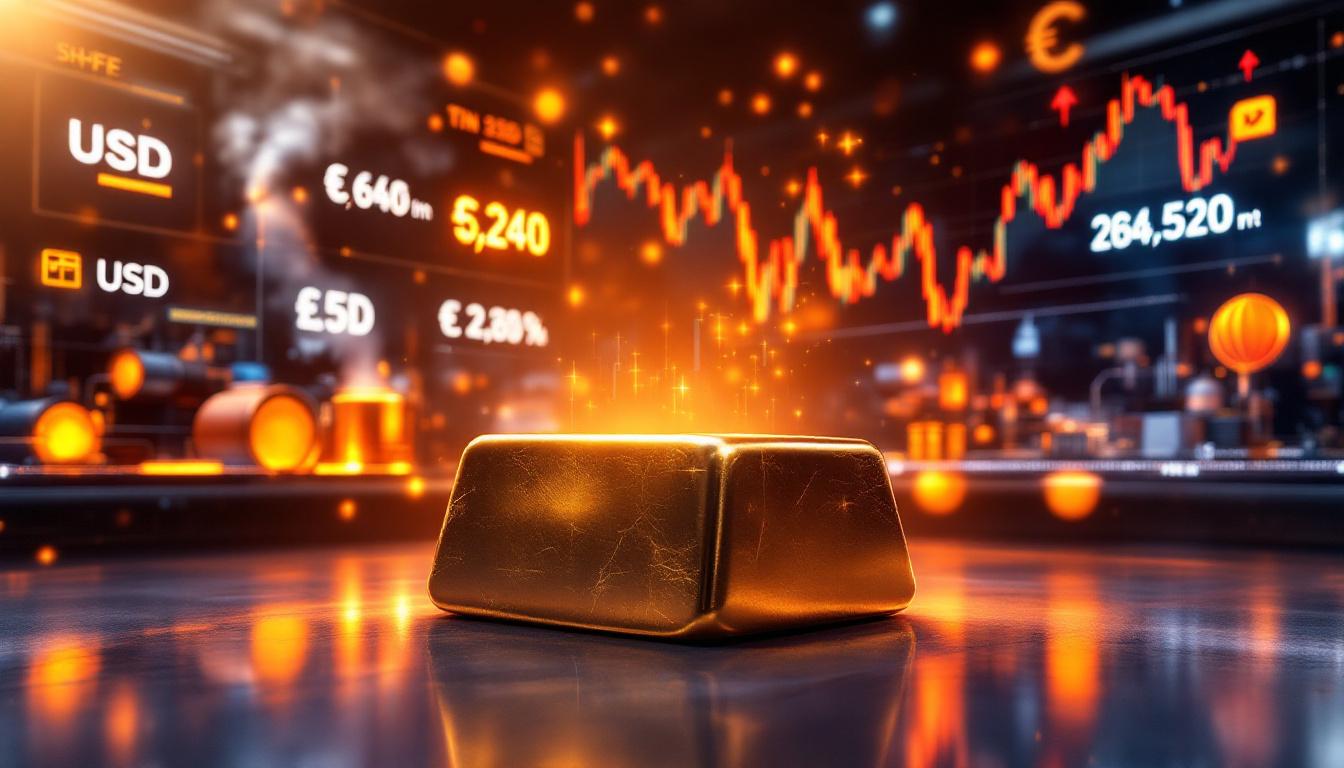What Are Platinum and Palladium?
Platinum and palladium represent two of the most misunderstood assets in the precious metals sector. These metals, classified as "fringe precious metals," operate within their own unique market dynamic that differs significantly from the more familiar gold and silver markets. Both currently trade around $1,000 per ounce—platinum at approximately $993 and palladium at $1,070 at the time of this analysis.
These elements belong to the prestigious "noble metals" category because of their remarkable chemical stability, resisting reaction with other elements even under extreme conditions. This inherent resistance to oxidation and corrosion makes them invaluable in numerous industrial applications. Physically, platinum has a density of 21.45 g/cm³, making it more than twice as dense as silver (10.49 g/cm³), while palladium at 12.02 g/cm³ is slightly denser than silver but significantly less dense than platinum.
Annual production figures highlight their scarcity—only about 190 tonnes of platinum and 210 tonnes of palladium are mined annually, compared to approximately 3,000 tonnes of gold. This production disparity underscores the extreme rarity of these platinum group metals, yet their prices don't always reflect this fundamental scarcity.
The Fundamentals of Platinum and Palladium
Both platinum and palladium exhibit extraordinary physical and chemical properties that make them irreplaceable in certain high-tech and industrial applications. Their high melting points (platinum: 1,768°C, palladium: 1,555°C) and exceptional resistance to chemical attack make them crucial in environments where other metals would quickly deteriorate.
Beyond their industrial applications, these metals have gained traction in investment portfolios primarily through ETFs, which currently hold approximately 3.3 million ounces of platinum—effectively removing a significant supply from industrial use. This investor stockpile represents approximately 16% of annual production, creating an interesting dynamic between investment and industrial demand.
The monetary history of these metals is less established than gold or silver, though platinum was briefly used for Russian coinage in the 19th century. Today, government mints produce platinum and palladium bullion coins, but their primary value proposition remains their industrial utility rather than monetary traditions.
Historical Price Performance
The price history of platinum and palladium reveals remarkable volatility. Platinum reached its all-time high of $2,213/oz in March 2008 during a perfect storm of supply constraints and strong automotive demand. Palladium's peak came much later, surging to nearly $3,000/oz in 2021 amid severe supply shortages and automotive industry recovery.
Historically, platinum commanded a premium over gold—a relationship that persisted for decades until a fundamental market shift occurred in 2011. By 2015, this historical trend had completely reversed, with gold becoming significantly more expensive than platinum. This price inversion has persisted and expanded, with the gold-to-platinum ratio now exceeding 3:1.
Palladium experienced its own dramatic journey, bottoming at approximately $167/oz around 2005 before embarking on a remarkable ascent that saw prices increase by over 1,700% to its 2021 peak. This volatility reflects the concentrated nature of both production and demand for these specialized metals.
Why Have Platinum and Palladium Underperformed Gold?
The Gold-Platinum Disconnect
While gold has surged approximately 65% since early 2023, platinum has remained stubbornly rangebound between $843 and $1,153 per ounce. This divergence has pushed the gold-to-platinum ratio to historically extreme levels exceeding 3:1, highlighting the fundamental differences in how these metals are valued in the marketplace.
The driving forces behind this disconnect are multifaceted. Gold trades primarily as a financial asset and inflation hedge, with physical industrial consumption representing less than 10% of annual demand. In contrast, platinum and palladium derive over 75% of their demand from industrial applications, making them far more sensitive to economic conditions and technological changes.
Central bank demand has provided significant price support for gold, with these institutions purchasing over 1,000 tonnes annually in recent years. No similar institutional buying exists for platinum or palladium. Additionally, geopolitical risks and sovereign debt concerns have boosted gold's safe-haven appeal while having minimal impact on the platinum group metals.
The correlation between gold and platinum prices has weakened considerably. Before 2011, the two metals often moved in tandem, but recent years have shown only moderate correlation, with platinum failing to participate in gold's major rallies. This decoupling highlights how differently these metals now trade despite their shared "precious" classification.
Industrial Demand Factors
Both platinum and palladium serve primarily as industrial rather than monetary metals. Their most significant application remains in catalytic converters for vehicles, where they catalyze reactions that neutralize harmful emissions. This automotive sector dependence creates vulnerability to technological disruptions and economic cycles.
Platinum fulfills crucial roles in the chemical industry, particularly in catalyzing reactions necessary for producing fertilizers. Without platinum's role in boosting the hydrogen revolution, many modern agricultural inputs would be impossible to manufacture efficiently. The metal also plays vital roles in petroleum refining and electronic components due to its exceptional conductivity and corrosion resistance.
Green technology applications represent an emerging demand center, with hydrogen fuel cells requiring platinum catalysts. A typical fuel cell vehicle uses between 30-60 grams of platinum, significantly more than the 3-7 grams found in traditional catalytic converters. As hydrogen technologies mature, this could represent a substantial new demand source for platinum.
Meanwhile, automotive electrification presents both challenges and opportunities. While battery electric vehicles eliminate the need for traditional catalysts, hybrid vehicles often require higher platinum group metal loadings. Additionally, hydrogen fuel cell vehicles could eventually consume significant quantities of platinum, potentially offsetting losses from battery electric vehicle adoption.
What Makes Platinum and Palladium Potentially Attractive Investments?
Supply Constraints and Market Deficits
The platinum market posted a substantial 749,000 ounce deficit in 2023, following a 527,000 ounce shortfall the previous year. Market analysts anticipate another deficit exceeding 470,000 ounces this year, creating a cumulative three-year supply shortfall approaching 1.75 million ounces—equivalent to nearly a full year of South African production.
These persistent deficits stem from several factors, including disrupted autocatalyst scrap flows that have hampered recycling efforts. The recycling pipeline typically exhibits a 2-5 year lag from vehicle scrappage to metal recovery, meaning today's high prices may not stimulate increased recycling supply until mid-decade.
The concentration of above-ground stocks presents another challenge, with significant inventories becoming inaccessible to key end users. Much of the available supply has been absorbed by Chinese imports and ETF holdings, creating physical tightness despite seemingly adequate overall inventories.
South Africa, the world's leading platinum producer, continues to experience ongoing power crises and labor issues that threaten production stability. The country's state utility Eskom implements "load shedding" (planned power outages) for up to 100 days annually, reducing mining output by an estimated 15%. These structural challenges constrain supply growth even during periods of higher prices.
Investment Demand Dynamics
Platinum ETFs currently hold approximately 3.3 million ounces of metal, effectively removing significant supply from industrial use. This investment overhang represents a double-edged sword—while it can pressure prices if liquidated, it also demonstrates substantial investor interest at current price levels.
Chinese import patterns reveal increased buying activity when prices drop to the low $900s, suggesting strong price support at these levels. Industrial buyers consistently identify this price range as an attractive entry point, creating natural demand when prices retreat. This psychological price floor has held during several recent correction attempts.
Following the November 2023 election in the United States, CME platinum warehouse holdings increased significantly from 545,000 to 585,000 ounces, representing a 7.3% rise. This accumulation suggests growing institutional interest in physical platinum as both an industrial and investment metal.
The unique supply-demand dynamics create potential value opportunities for patient investors. With all-in production costs averaging around $900-950 per ounce for many miners, prices near or below $1,000 appear unsustainable in the long term without triggering production cuts that would further exacerbate supply deficits.
Market Structure Indicators
Market analysts have identified potential for "backwardation" in the platinum futures curve by 2025, a condition where spot prices exceed futures prices. This unusual market structure typically reflects a premium for immediate delivery, signaling physical metal scarcity despite adequate paper market liquidity.
Heavy metal flows to China during 2021-2022 absorbed surplus stocks that had accumulated during the pandemic production slowdown. These inventory shifts have created regional tightness in certain markets while appearing well-supplied in others, complicating price discovery mechanisms.
CME platinum's managed money positioning demonstrates remarkable volatility, swinging between net long and net short positions based on short-term technical factors rather than fundamental value. This speculative activity often exaggerates price movements in both directions, creating tactical opportunities for contrarian investors.
The growing disconnect between paper trading volumes and physical metal availability suggests potential for significant price dislocations if industrial users begin securing physical inventories more aggressively. Such behavior could trigger a positive feedback loop where price increases stimulate additional inventory building.
How Should Investors Approach These Metals?
Investment vs. Speculation Considerations
Platinum and palladium investment is not recommended as primary inflation hedges in the same manner as gold and silver. Their industrial demand dependency makes them more correlated with economic conditions than monetary factors, limiting their effectiveness during financial crises.
These metals are better positioned as diversification tools within a broader precious metals portfolio. Allocating 5-10% of a metals portfolio to platinum and palladium can provide exposure to different economic factors than gold and silver, potentially improving overall risk-adjusted returns.
Prices under $1,000/oz have historically represented good entry points for long-term investors. At these levels, the metals trade near or below production costs, limiting downside risk while maintaining substantial upside potential if supply continues to lag demand.
Long-term investors should consider the potential for significant price breakouts due to continued supply shortages. The cumulative deficit expected between 2023-2025 approaches 1.75 million ounces, a substantial imbalance that will eventually require higher prices to resolve through either increased production or demand destruction.
Short-term price movements provide opportunities for tactical positioning, but investors should recognize the higher volatility characteristic of these smaller markets. Position sizing should reflect the additional price risk compared to gold or silver.
Collector Appeal Factors
Beyond their investment attributes, platinum and palladium offer unique aesthetic qualities distinct from gold and silver. Their silvery-white appearance with subtle hue differences (platinum has a slightly darker tone) provides visual diversity within a precious metals collection.
Lower mintage numbers for certain products enhance collector appeal. The Palladium American Eagle series, introduced in 2017, features significantly smaller production runs than its gold and silver counterparts. The 2020 W-minted Palladium Eagle had a particularly limited mintage of just 8,827 coins, creating strong numismatic interest.
Certain issues offer numismatic potential that can outpace metal price performance. For example, MS70-graded 2020 Palladium Eagles have traded at premiums exceeding 125% over spot value, compared to approximately 30% for generic examples. This "double play" potential appeals to those seeking both metal exposure and collectible appreciation.
New designs like the 2025 Platinum Maple Leaf featuring King Charles III represent historical numismatic significance as the first platinum coins bearing the new monarch's effigy. Such "first of kind" issues often command substantial premiums among collectors independently of metal price movements.
FAQs About Platinum and Palladium Investment
Are platinum and palladium good inflation hedges?
Unlike gold and silver, platinum and palladium have not proven themselves as reliable inflation hedges. They function primarily as industrial metals with investment characteristics, making them more suitable for portfolio diversification than core wealth preservation. Their price correlation with inflation measures has been inconsistent historically, limiting their effectiveness during purely monetary crises.
What drives platinum and palladium prices?
Industrial demand accounts for the majority of price movements, particularly from the automotive sector for catalytic converters. Automotive production cycles can significantly impact prices, with the post-pandemic recovery demonstrating this connection. Supply disruptions, particularly from South Africa for platinum and Russia for palladium, can cause significant price spikes due to the concentrated nature of production. Furthermore, mining's crucial role in the clean energy transition affects demand for these metals.
How rare are platinum and palladium compared to gold?
Both metals are significantly rarer than gold in the earth's crust. Annual platinum production is approximately 190 tonnes compared to 3,000 tonnes for gold, while palladium production is around 210 tonnes annually. This production ratio highlights the extreme scarcity of these metals, with the world producing about 15 times more gold than platinum each year. This scarcity has implications for navigating resource nationalism in the critical minerals race.
What are the physical differences between platinum and palladium coins?
Palladium coins are typically larger in diameter than platinum coins of the same weight due to platinum's greater density (21.45 g/cm³ vs. 12.02 g/cm³). Both have a similar silvery-white appearance, though platinum has a slightly darker hue. Platinum's greater density also makes it more resistant to wear, providing better longevity for frequently handled pieces. For those interested in precious metals, a beginner's guide to investing in mining stocks can provide broader context.
What percentage of a precious metals portfolio should include platinum and palladium?
Most experts recommend limiting platinum and palladium to no more than 5-10% of a precious metals portfolio due to their higher volatility and industrial demand dependency. This allocation provides meaningful diversification benefits while limiting overall portfolio volatility. Investors with specific industry knowledge or stronger risk tolerance might consider slightly higher allocations during periods of extreme undervaluation. Additionally, understanding decarbonisation in mining and the clean energy revolution can help inform investment decisions in this sector.
For those wanting to learn more about these unique precious metals, Provident Metals' guide on platinum and palladium investing offers comprehensive insights for both new and experienced investors. Additionally, Forbes' analysis on the potential double-barreled boost for platinum and palladium provides current market perspectives worth considering.
Looking to Capitalize on the Next Rare Metals Opportunity?
Stay ahead of the market with Discovery Alert's proprietary Discovery IQ model, which delivers real-time alerts on significant platinum and palladium discoveries on the ASX. Understand why these rare metals can lead to exceptional investment returns by exploring our dedicated discoveries page, and begin your 30-day free trial today.




